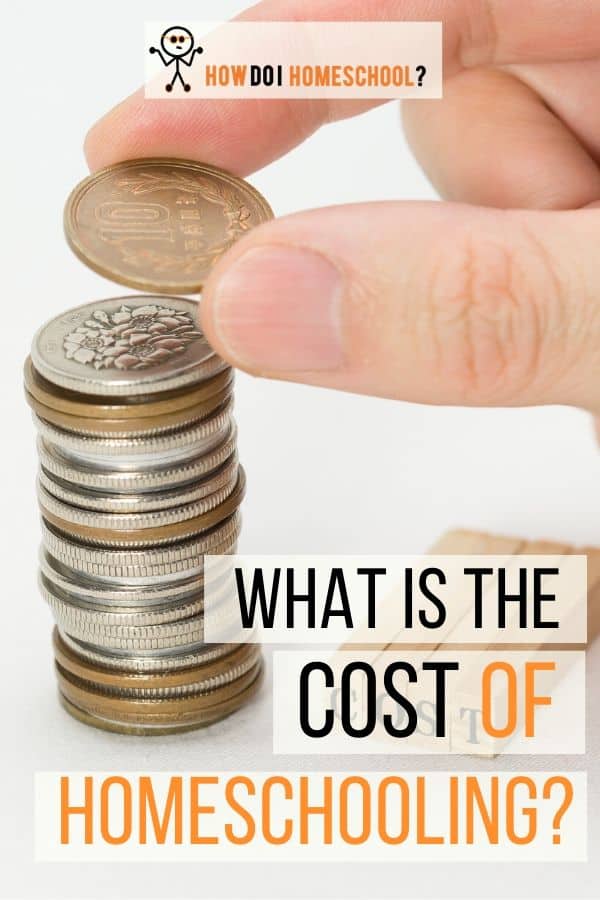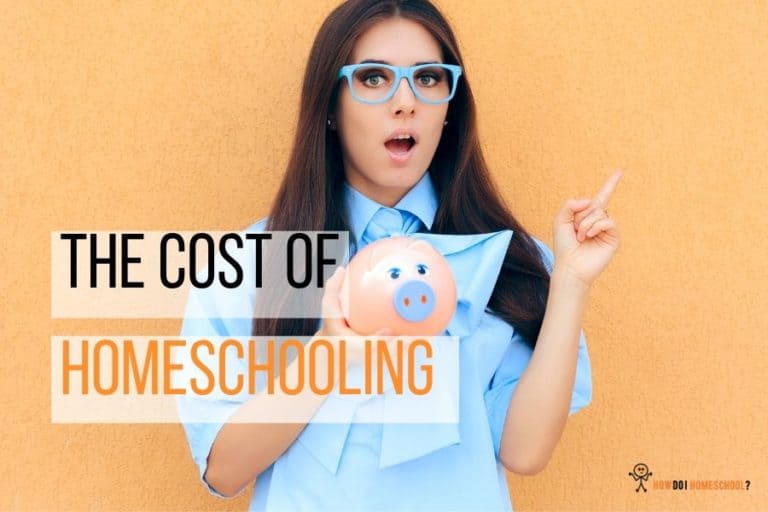If you’re considering home education, chances are you’re looking closely at how you can afford to homeschool your children on a single income. What exactly are the costs of homeschooling, and where can you get resources at a great price (or free) so you can make it affordable. Sadly, some people believe home education is too expensive for the average family. But, I’m going to show you just how inexpensive it can be!

I hope you enjoy reading this blog post. If you want to do my course on how to homeschool, click here.
In this article, we’ll cover the following topics:
- How to afford home education on a single income
- The price for one year
- How to lower costs by using online resources and printables and
- Coalitions and how they can help you reduce your costs
Let’s jump straight in and have a look.
How to Afford Homeschooling on a Single Income
Unless the primary breadwinner in your family is on a good income, you’ll probably find yourself making choices that involve a considerable sacrifice for you to make homeschooling affordable.
Some of these sacrifices involve giving up things you value tremendously, such as:
- giving up one income,
- selling one of your cars and sharing the remaining one to save on registration, car maintenance, and any other expenses this luxury comes with
- selling a house, and moving into a cheaper home with cheaper mortgage repayments,
- telling your friends you can’t eat out because the budget isn’t there for it,
- giving up fancy holidays and becoming familiar with caravan parks,
- eating peanut butter and honey sandwiches for lunch with baked beans for dinner,
- going flexitarian, vegetarian or vegan to save on the cost of meat,
- foregoing expensive holidays for fewer vacations or less costly options,
- and (perhaps the hardest for some of us) reducing our coffee budget!
Depending on what the primary breadwinner earns, you can see that home education costs are high and require many sacrifices. At this point, it might be helpful to read all the reasons to homeschool to assure yourself that it’s going to be worth it (and it is!).

Is Homeschooling Too Expensive?
Some believe the cost of homeschooling is too high. Most families, after all, pay government taxes and, therefore, many parents think they should send their children to public schools, so they don’t have to pay for their children’s education twice.
While home education costs will never be cheaper than public school, consider the point that the education your children will get at home will likely be vastly superior to that of a public school. (Many other advantages come when you choose to homeschool.)
With a bit of frugal penny-minding, home education is affordable.
You can do many things to cut your costs, like opting for a free curriculum or hunting down inexpensive resources. Essentially, home education is as expensive as you want to make it.
For example, you can make homeschooling more affordable by choosing a free curriculum, like Easy Peasy. If you’re on a tight budget, you don’t need a paid curriculum like BJU or Abeka (although, if you have the funds, I’d choose a paid curriculum like BJU).
The advantage of homeschooling is parents can buy, borrow or rent books from different sources such as friends or libraries, depending on their budget. In addition, these books can be reusable with subsequent children. (My parents bought us our own Abeka workbooks but kept the same teacher’s manual for all three children).
Homeschooling Cost for One Year
Homeschooling costs #1
Vickey Bentley says the cost of homeschooling for a family of three can be less than $2,275 USD (or $758 per student) a year:
- Sample for three children in a satellite program with some teacher support (K, 2nd, and 8th):
- Curriculum – $1,370
- Annual testing – $0 (included in program, $75 value)
- Professional memberships – $175
- Home library – $100
- Annual convention (parents) – $100 (commute)
- School supplies – $150
- Art lessons (1 mo, oldest) and softball – $80
- Miscellaneous – $300
Total$2,275 [$758/student/year]

Homeschooling costs #2
Time4Learning assessed expenses as similar to Vicky Bentley:
The average cost of home educating one child per year might fall within the following ranges.
- Curriculum: $350-750
- Materials: $150-300
- Field Trips: $100-$250
- Extracurriculars: $100-$500
Approximate total cost per year per student: $700-$1800
Homeschooling costs #3
An Everyday Story budged an incredible $400/ a month:
Your homeschool budget will depend on your variable expenses and your disposable income. We have budgeted $400/month for materials, memberships, and extra-curricular classes. Approximately half of this is paid upfront (swimming lessons, memberships, that sort of thing), leaving $200/mth or $50/week cash, which I spend on materials and excursions. This includes all materials, from pens and paper to more expensive items.
(- Deleted article from An Everyday Story)
If you’re a little intimidated and you’re thinking, ‘How can I afford this option if I don’t have $400 a month?’, don’t worry because you don’t need that much. One of the comments on this blog explained this saying,
‘Wow! I can’t imagine having the luxury of a $400 a month budget! We probably don’t spend that much in a year. It is, of course, much less expensive to homeschool elementary children than teens, but there are so many ways to keep costs low while still offering kids an excellent education.’
(- Deleted article from An Everyday Story)
What is the Cost of Homeschooling for One Year?
So, the cost of homeschooling for one year averages out to be around $2,000 a student per year. But, you can significantly reduce these costs by reusing old books and bypassing optional lessons, like horse riding.
Lower Your Expenses by Using Online Resources and Printables
Free, online resources are plentiful.
eBooks, free curricula printable worksheets are everywhere and readily available for homeschooling parents. Two good options are An Old Fashioned Education and Freedom Homeschooling. (The latter specifically marks out Christian resources for parents who want to use Christian materials.)
You can find many free books these days because they’re past patent protection. This means that they’re available for no cost online to be downloaded from different sources such as the public domain.
There are also many educational games online for free such as typing or reading programs (easily discovered upon googling). Finally, for those who might need a complicated Algebraic equation explained, there are excellent video options like Youtube or the Khan Academy.

Saving Money With Homeschool Coalitions?
Families can volunteer their time in homeschool coalitions to reduce home education costs. These coalitions can be either a group of home-educating families that pool their resources to get more bang for their buck OR an organization that takes a fee to provide good quality subjects for homeschoolers.
For coalitions that consist of groups of families: These families might pool their resources to reduce the cost of homeschooling and hire a tutor to teach their children a subject, like languages. Alternatively, one parent might teach the children their specialty. For example, if a parent is an artist, they might take art lessons; if another parent is a scientist, they could take science and so on.
For large coalition organizations: these options aren’t always as cost-effective as the family-led coalitions, although they may be considerably more organized. For example, if you study with Classical Conversations, you’ll get an excellent classical education, but it may not be a very cheap option. Quite a number of home-educating families in America attend organized coalitions, although this is less common in other countries.

Conclusion
Happily, home education isn’t just for the wealthy. The cost of homeschooling is affordable for most people if they’re willing to make the necessary sacrifices. But, is our educational choice all about the money, or are we doing it because we value our children’s education more than money? It’s good to realign our thoughts by remembering the reasons we’re considering home educating in the first place. Homeschool mom, Barbara Fraser, got at the heart of the matter when she said, ‘Can you afford to send them to school and not have them grow in Christ?’



